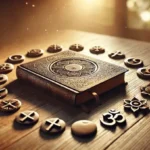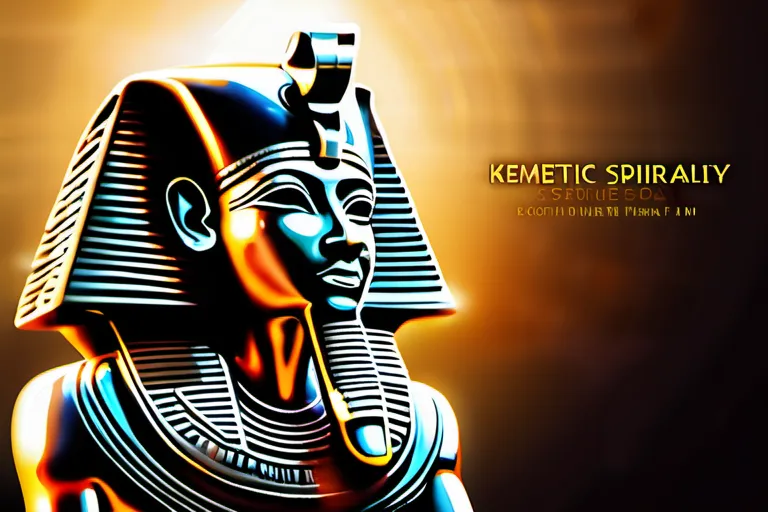Explore the unique aspects of Kemetic spirituality and compare it with other belief systems.
Delve into the fascinating world of Kemetic spirituality, an ancient Egyptian religious system, and learn how it differs from other belief systems. This article will provide a comprehensive comparison to help you understand the unique aspects of this spiritual practice.
The Origins and History of Kemetic Spirituality
Imagine stepping back into time, walking through the hallowed halls of ancient Egypt, where Kemetic spirituality flourished. How did this spiritual tradition, rooted in the rich history and mythology of ancient Egyptians, evolve over millennia? Let’s explore its origins and delve into the tapestry of its historical development.
The journey begins with the pharaohs themselves, who were often seen as living gods, embodying both human and divine qualities. This belief system was not just a religion; it was woven into the very fabric of daily life, politics, and culture. Who could have imagined that such an intricate web of beliefs and practices would endure through centuries?
From the pyramids to the temples, every structure held a story, each statue represented a deity, and every hieroglyphic spoke volumes about the ancient Egyptians’ connection with their gods. The concept of Ma’at, representing truth, balance, order, morality, and justice, was central. How did this idea shape the social and spiritual life of its people?
The history of Kemetic spirituality is a complex narrative, intertwined with the rise and fall of dynasties. As Egypt’s power waned, so too did its religious practices, only to resurface in modern times. Today, how does this ancient wisdom find relevance in contemporary society? The journey from the tombs of kings to the global diaspora is both fascinating and enlightening.
The ennead, a group of deities representing different aspects of creation and governance, was also a cornerstone. Each deity had its own unique role and significance, yet they were interconnected in a vast cosmic web. How did these divine relationships influence the spiritual practices and daily lives of ancient Egyptians?
As we trace the history of Kemetic spirituality, it becomes clear that this tradition is more than just a collection of beliefs or rituals; it’s a profound exploration of human existence, purpose, and connection to the divine. The legacy of Kemetic spirituality continues to resonate, offering insights into the timeless questions of life.
Key Beliefs and Practices in Kemetic Spirituality
Kemetic spirituality, steeped in the rich tapestry of ancient Egyptian beliefs, offers a unique lens through which one can view the world. But how does it differ from other belief systems? Let’s delve into the core tenets that make Kemetic spirituality distinct.
Ma’at, the concept of cosmic order and truth, is central to Kemetic thought. Is this not a principle we all strive for in our lives? Just as Ma’at symbolizes balance and harmony, it also represents the moral order that governs the universe. In Kemetic practices, adherents seek to align their actions with Ma’at, ensuring they live in accordance with these principles.
The ennead, a group of nine deities including Ra, Hapi, and Osiris, forms another cornerstone of Kemetic belief. Each deity represents different facets of existence, from creation to death. Could we not see the ennead as a metaphor for the interconnectedness of all things? By venerating these deities, followers believe they are partaking in the greater cosmic order.
The role of deities in Kemetic spirituality is both active and present. These divine beings are seen as intermediaries between humans and the supreme being Ptah. Worshipping them through offerings, prayers, and rituals ensures that one remains on the right path according to Ma’at. Isn’t this similar to how we might seek guidance from spiritual leaders in our communities?
In contrast to other belief systems, Kemetic practices emphasize a holistic approach where every aspect of life is seen as part of a larger divine plan. The deities are not distant but are closely involved in the lives of their followers. This interactivity and personal connection with the divine make Kemetic spirituality uniquely engaging and deeply meaningful.
Comparing Kemetic Spirituality with Other Ancient Belief Systems
When we delve into the rich tapestry of ancient belief systems, Kemetic spirituality stands out like a unique star in the cosmos, distinct from other ancient practices such as Greek and Roman polytheism. How does one begin to grasp the essence of Kemetic spirituality when compared to these more familiar systems? Is it not like comparing apples to oranges, or are there deeper layers that reveal their interconnectivity?
In Kemetic spirituality, deities are seen as embodiments of cosmic forces, each with specific roles and functions within the universe. This contrasts sharply with Greek and Roman polytheism, where gods often had human-like traits and more personal relationships with mortals. In Kemetic practice, the focus is on maintaining balance and harmony through rituals and offerings to ensure the well-being of both individuals and the cosmos as a whole.
Consider the concept of Ma’at, central to Kemetic beliefs, representing order, truth, and justice. It’s akin to how Greek gods might impose order in their own way, but Ma’at is more about an intrinsic balance that guides all aspects of existence. In contrast, Roman practices often revolved around personal piety and state religion, with less emphasis on cosmic harmony as a fundamental principle.
The Ennead, the pantheon of nine major deities, also sets Kemetic spirituality apart from other ancient systems. Each deity in this group holds significant power and importance, reflecting the interconnectedness of all aspects of life. This is different from the Greek pantheon, where individual gods often competed with each other or had distinct domains that were less interrelated.
Moreover, Kemetic rituals are deeply rooted in daily life, serving as a means to honor the gods and ensure the sustenance of Ma’at. These practices are not just occasional observances but integral parts of everyday existence, mirroring how Greek and Roman rituals were also woven into the fabric of society.
By exploring these distinctions, we see that while Kemetic spirituality shares some commonalities with other ancient belief systems, it also holds unique characteristics that set it apart. It’s like comparing a vibrant tapestry to a rich mosaic, each offering its own intricate beauty and depth.
Modern Practices of Kemetic Spirituality
How does one practice Kemetic spirituality today, you might ask? It’s like navigating through a rich tapestry woven with threads of history and modernity, where ancient rituals meet contemporary lifestyles. Modern Kemetics engage in a variety of practices that honor their spiritual heritage while adapting to the present world.
Rituals are at the heart of Kemetic spirituality today. Just as in ancient times, these rituals involve offerings, prayers, and ceremonies dedicated to the gods. For instance, many practitioners might offer libations or incense during a daily ritual, much like pouring out a virtual libation into the digital stream of our modern lives. This keeps the connection alive between the past and present.
Community involvement is another crucial aspect. Modern Kemetic communities often gather for festivals that celebrate the gods and goddesses. These gatherings can range from intimate indoor sessions to large outdoor events, mirroring the communal bonds found in ancient Egyptian society. Think of it as a modern-day version of the lively markets or festivals depicted on ancient tomb walls, only now with people dressed in contemporary attire.
The practices also extend beyond rituals and festivals into daily life. Many Kemetics incorporate spiritual principles into their routines, much like how one might integrate mindfulness or yoga into their everyday lives. This could mean setting aside a moment each day to meditate or reflect on the divine presence in their surroundings.
Moreover, modern Kemetic spirituality embraces education as a path to deeper understanding. Many practitioners study the ancient texts and learn about the deities, engaging with the rich history that underpins their beliefs. This ongoing exploration keeps the spiritual practices relevant and alive, much like how a gardener tends to their plants, ensuring they thrive in new environments.
In essence, modern Kemetic spirituality is not just about resurrecting old practices but about integrating them into contemporary life. It’s about finding meaning and connection through ancient wisdom, making it a vibrant, living tradition rather than a relic of the past.
The Role of Deities in Kemetic Spirituality
Have you ever wondered about the role deities play in Kemetic spirituality? Unlike some other belief systems, where gods might be seen as distant figures, in Kemetic practice, deities are deeply integrated into daily life and spiritual activities. Let’s dive into the fascinating roles of key deities like Ra, Isis, and Osiris, exploring why they hold such a central place.
Imagine Ra, the sun god, as the eternal journeyer across the sky, bringing light and warmth to Egypt. In Kemetic spirituality, he is not just a celestial figure but a constant reminder of life’s cyclical nature. His daily ascent into the heavens and descent into the underworld mirrors the rise and fall of the Nile, symbolizing the cycle of birth, death, and rebirth. Can you see how this god’s journey becomes a metaphor for our own lives?
Now, consider Isis, the goddess of magic, motherhood, and healing. She is often depicted as a protective figure, her powerful spells weaving through the fabric of life. In Kemetic practice, she serves as a guide to navigating the complexities of existence, offering comfort and solace in times of need. How might it feel to have such a nurturing presence in your life, always ready to offer guidance and support?
And what about Osiris? The god of death and resurrection, he embodies the ultimate cycle of transformation. His myth is one of sacrifice and renewal, teaching us that even in the darkest moments, there is hope for rebirth. Could you imagine a world where such an idea became not just belief but a lived reality?
In Kemetic spirituality, these deities are more than just figures—they are integral parts of the divine community. Their stories, filled with drama and depth, provide guidance on how to live in harmony with the natural order. Through rituals and prayers, practitioners seek connection and understanding, drawing strength from their faith.
The Impact of Kemetic Spirituality on Modern Culture
Imagine stepping into a museum where ancient artifacts tell stories of gods and goddesses, their powers, and their influence on human lives. Now, picture how these tales have woven themselves into our contemporary world, transforming modern culture in unexpected ways. This is the impact that Kemetic spirituality, with its rich tapestry of deities and rituals, has had on today’s society.
One cannot help but wonder: How do the symbols and stories from ancient Egypt find their way into our current artistic expressions? From the vibrant paintings adorning gallery walls to the intricate designs of jewelry, Kemetic motifs have left an indelible mark. These images often depict deities like Ra, with his fiery sun disc or Isis, portrayed in her nurturing role, embodying themes of protection and wisdom.
But it’s not just visual arts that are influenced; literature also reflects this ancient heritage. Authors draw inspiration from Kemetic myths and legends to craft characters and narratives that resonate deeply with readers. Consider the theme of rebirth and transformation: these ideas were central in Kemetic spirituality, with figures like Osiris being symbolically resurrected after death. This concept has inspired countless works, from novels to screenplays, where protagonists undergo profound changes, much like their Kemetic counterparts.
In popular media too, we see the enduring influence of Kemetic spirituality. Shows and movies often incorporate elements of Egyptian mythology, whether it’s through visual cues or plotlines that borrow from these ancient narratives. The power of storytelling cannot be overstated; it shapes our understanding of the world around us, and in this sense, Kemetic myths continue to captivate and inspire.
As we explore the profound impact of Kemetic spirituality on modern culture, we find ourselves questioning how deeply intertwined the past is with the present. These stories, once told only by priests in sacred temples, now permeate our daily lives through art, literature, and media. It’s a testament to the timeless nature of these beliefs that they continue to shape our perceptions and experiences.
Conclusion
 By comparing Kemetic spirituality with other belief systems, we gain a deeper appreciation for its distinct practices and beliefs. Whether you’re a curious beginner or an experienced practitioner, this article offers valuable insights into the world of Kemetic spirituality.
By comparing Kemetic spirituality with other belief systems, we gain a deeper appreciation for its distinct practices and beliefs. Whether you’re a curious beginner or an experienced practitioner, this article offers valuable insights into the world of Kemetic spirituality.











